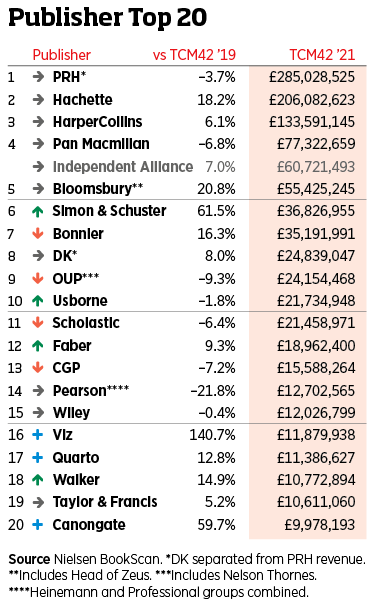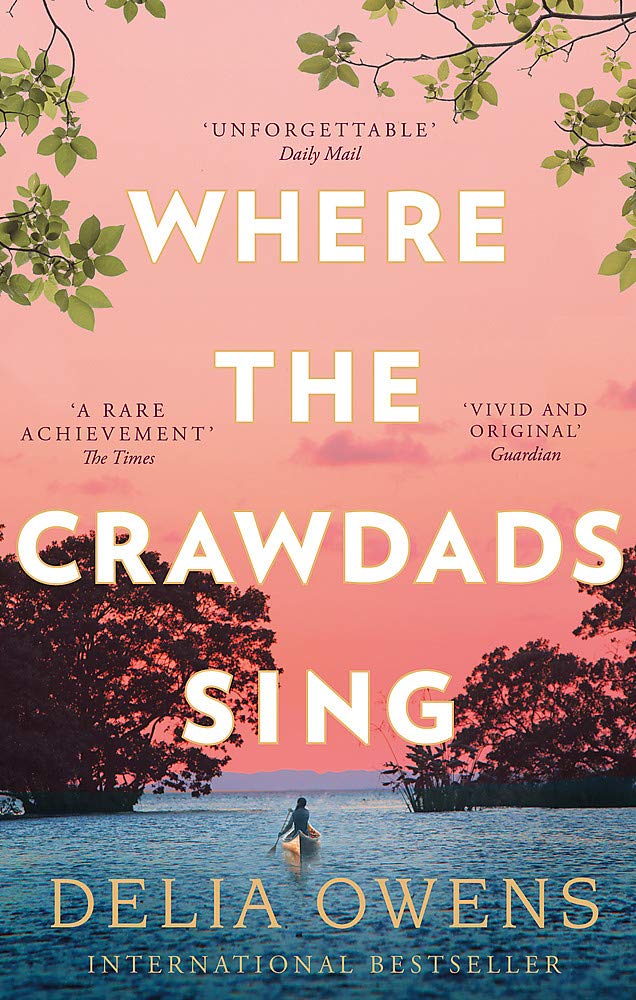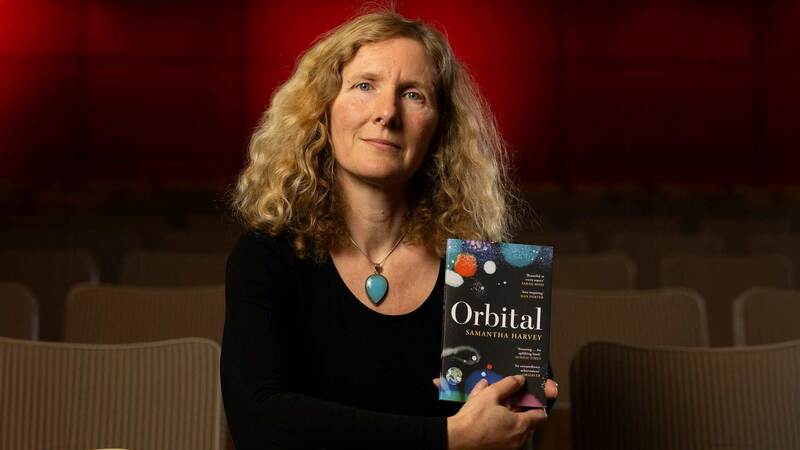You are viewing your 1 free article this month. Login to read more articles.
Publishers report brisk business beyond TCM42
Representatives at some of the UK’s biggest publishers have supplied data to broaden out the picture regarding their performance in the past year.
There have been a lot of caveats when assembling the Reviews of the Year during the pandemic period with missing Nielsen BookScan data owing to lockdowns. We have had a better look at 2021 compared to the first year of the pandemic, with the TCM42 (the last 42 weeks of 2021 which excludes 10 lockdown weeks) a pretty solid metric.
And it’s very solid when we look at publisher performance. More than solid for some: astonishingly, 78 of BookScan’s 476 publisher groups (omitting defunct entities) notched up record returns through 2021’s TCM42 compared against previous full years, including heavy hitters like Simon & Schuster, John Murray, Manga list Viz, Nosy Crow and Head of Zeus.
But those 10 missing weeks are no small slice of the pie: subtracting TCM42 revenue from BookScan’s full 52-week estimate of £1.82bn (an all-time record, by the way) would mean £300m worth of print books were sold in the first 10 weeks last year.
Hidden figures
So, to augment the data at our disposal we canvassed some of the larger groups for figures from the 10 weeks to fill in the lockdown black hole. Publishers measure performance slightly differently and understandably have provided different data sets that show their performance. Some can fill in the gaps completely, some are restricted because of company policies. Thus, we have mostly used TCM42 data in our charts and when comparing groups across following pages, but will flesh out some of those figures below.
HarperCollins is the one among the Big Four most closely aligned percentage-wise between its internal full-year figures and TCM42: it has an 8.8% slice of the overall market in value terms through the truncated year; its internal 52-week data says an almost identical 8.7%
Top-of-the-table Penguin Random House has £285m TCM42 revenue but it had a number of early-year hits that are excluded. PRH’s own top 50 data for the full year shows sales of 7.8 million units for £60.1m, 17% and 14%, respectively, above its TCM42 takings (for the equivalent top 50). A couple of Ebury authors may feel aggrieved: PRH’s internal sales has Charlie Mackesy’s The Boy, the Mole, the Fox and the Horse on almost 607,000 copies for £6m, compared to the “paltry” 368,000 units for £3.7m in TCM42. Stacey Solomon’s Tap to Tidy had the last two overall UK number ones of 2021’s lockdown period and PRH says she earned a smidge under £2m, way up on the £558,000 through TCM42.
Hachette had a brilliant year through the TCM42, earning £206.1m, with its value share of the overall market rising to 13.5% and 11 of its 13 divisions with BookScan publisher groups in growth. It provided volume data—our Reviews of the Year are primarily value-focused—which suggests an even stronger year when looking across the full 52 weeks. Hachette says it sold 29.9 million units last year, which is 4.9 million more than through TCM42. That gives it a volume share of 14.4%, based on BookScan’s full-year 212.7 million-unit estimate. The group sold a hefty 5.7 million more print copies in 2021 than it did in 2019, a whopping 23.7% jump over the two years.
Late bloomer
HarperCollins is the one among the Big Four most closely aligned percentage-wise between its internal full-year figures and TCM42: it has an 8.8% slice of the overall market in value terms through the truncated year; its internal 52-week data says an almost identical 8.7%. That is partially because it is the conglomerate with the fewest big hits out in the first quarter of 2021: of its top 100 books of the year, 66 were published after lockdown ended. That’s not to say some authors didn’t take a hit; HC says saga star Dilly Court’s The Reluctant Heiress sold 95,000 copies, almost 70,000 units more than it registered in TCM42.
We note in our deeper look at Pan Mac that its £77.3m TCM42 haul was a great result. Internal Pan Mac data suggest it was better. In fact, Pan Mac says its full-year sales in volume was 12.8 million (only 2019’s 13.5 million exceeded that) and “we’ve confirmed that this was our biggest ever value year… up 8.5% on 2020”. Corporate rules mean it cannot be specific about the value, but the group is closing in on the £100m barrier for the first time. Kids’ was a big driver, with Macmillan Children’s recording its biggest year ever with value up 23%, while Fiction had a record, too, up 8% by value.
Bloomsbury provided figures for the first eight months of 2021 versus the same period in 2020, with sales rising 16% to £42.6m. It said its adult trade business was up 18% (before the acquisition of Head of Zeus added further growth). Backlist drove sales across children’s, adult fiction and cookery, including Madeleine Miller’s TikTok-boosted The Song of Achilles and Circe, Priory of the Orange Tree by Samantha Shannon and a series uplift for Sarah J Maas.
Simon & Schuster said its full-year TCM sales by value were up 39% on 2020, with gains across children’s (+48.5%), fiction (+25%), and non-fiction (+45%).
Simon & Schuster: Shooting Star helps S&S to record year
This will be decided by the US courts, but this may be the last time Simon & Schuster appears on a Review of the Year before it becomes part of the Penguin Random House machine. If so, it departs the field on a high, or rather the highest: its TCM42 revenue of £36.8m shattered the previous full-year best (2015) by £4.4m.
It had the massive hits from Bob Mortimer with almost £4m taken in, and Dave Grohl (£2.8m), while no publisher has benefitted more from TikTok, which turned Colleen Hoover, Adam Silvera and Taylor Jenkins Reid’s backlist into gold as the trio combined to earn £4.5m for S&S. As this week’s charts pages attest, the trend shows little sign of slowing down in 2022.
A doughty solidity underpins it for Simon & Schuster. S&S Children’s is surging, led by the likes of Katie and Kevin Tsang, “Death in Paradise” star turned author Ben Miller and Supertato creators Sue Hendra and Paul Linnet. Fiction soared, too, helped by fine years from Santa Montefiore and Rachel Hore. S&S did so well it did not suffer from a lack of a Philippa Gregory hardback, though the publisher’s long-time superstar still shifted £831,000.
Other Publisher Groups: notorious OPG tops PRH through TCM
The biggest publishing entity on BookScan is technically not Penguin Random House or Hachette, which are split into divisions, but Other Publisher Groups (OPG), a catch-all for thousands of micro and small presses (And Other Stories, Galley Beggar, Hoxton Mini Press); digital lists dipping a toe into print (Joffe Books); foreign, particularly US-headquartered firms, publishing in the UK (Houghton Mifflin, Sourcebooks); self-publishers; and very niche concerns, like Wisconsin-based Dogwise, whose canine behaviour guides include the provocatively titled When Pigs Fly: Training Success with Impossible Dogs.
Collectively, OPG is big business, earning £165.7m through TCM42 in 2021, by far its BookScan record. Part of the boom is a migration of indie authors after Amazon wound up its print self-publishing arm Createspace in favour of KDP Print in 2020. Some 10% of the revenue comes from indie-published titles, though that excludes self-publishers and hybrid authors who have set up a publishing house like L J Ross’ Dark Skies.
Tops is the impressively named Strumpshaw, Tincleton & Giggleswick, a mapmaker whose Great British Adventure Map has shifted 42,000 copies, OPG’s biggest mover by volume. Callaway Editions’ £813,000 revenue is from one title: the tie-in to the Disney+ “The Beatles: Get Back” documentary series.
Penguin Random House: house ruled by flying Penguin
Those, ahem, wise enough to remember a pre-PRH time may be interested to note Penguin’s TCM42 earnings of £152.6m is the first time in the BookScan era that the “P” side has outsold the “RH” in a calendar year (the Transworld and Random House groups combined for £132.4m). It was a data-shortened year, but the gap had been closing for a while: RH was £5m ahead in 2019, but pre-merger RH regularly had a buffer of at least £50m over Penguin.
Penguin was up 5.3% in TCM42 against the same period in 2019; its £152.6m is a better return through BookScan than in all but four full years. Joanna Prior leaves Penguin General for Pan Mac with her division singing: the long shadow of Richard Osman’s £11.9m did not obscure other hits, like John le Carré’s swansong Silverview (£1.3m) and burgeoning cookery star Stanley Tucci, whose Taste (Fig Tree) earned £1m. Penguin Michael Joseph scored with Jeremy Clarkson’s Diddly Squat (£2.4m), Jamie Oliver served up the usual (£3.3m) and £950,000 came from James Norbury’s Charlie Mackesy-esque Big Panda and Tiny Dragon.
More than two years after publication, Mackesy’s The Boy, the Mole, the Fox and the Horse was PRH’s top non-fiction (£3.7m) title through TCM42. Five Random House titles earned £1m-plus, and Ebury accounted for the first four of them: Mackesy, Jane Dunn’s Jane’s Patisserie (£2.2m), Mary Berry’s Love to Cook (£1.7m) and Yotam Ottolenghi and Noor Murad’s Ottolenghi Test Kitchen (£1.3m).
Transworld dipped 31% through TCM42 to £24.4m. The Brothers Child contributed the two big hits, Better Off Dead (£2.1m) and The Sentinel (£1.3m), and the Jack Reacher business will undoubtedly open a can of ass-whup on 2022, with a tie-in series on Amazon Prime. But there were few other blow-the-doors-off smashes as new books from some old reliables did not hit previous heights.
PRH Children’s does not have a discrete BookScan entity, but children’s sales across PRH were £53.9m, a 14.5% share of the overall kids’ market and a 19% slice of the overall group. Tom Fletcher has edged out Jeff Kinney as the star: he shifted £5.4m to Kinney’s (still impressive) £4.8m, and authored five of the division’s top 10 books, including its bestseller, his and illustrator Shane Devries’ The Christmasaurus and the Naughty List.
Hachette: stellar year at Carmelite House
A brilliant year across Hachette, which increased its market share from 12.2% in 2019 to 13.5%. Eleven of its 13 groups were in value growth through TCM42, nine of which had double-digit percentage rises.
John Murray Press’ record £15.2m was £300,000 clear of its previous high-water mark (2019), buoyed by Billy Connolly and Miriam Margolyes’ memoirs, which combined to shift £6.5m. Bookouture’s enviably profitable model is primarily digital, but it has been dipping into print. Its record of £847,000 was chalked with only eight titles topping 1,000 units, led by K L Slater’s The Marriage (3,137).
Top dog Little, Brown’s TCM42 £35.6m beat its full-year 2019 total (although that was its worst-ever year through BookScan). Delia Owens’ Where the Crawdads Sing (£1.4m) continued to soar, while Brit Bennett’s The Vanishing Half (£1.1m) was imprint Dialogue Books’ biggest success since launch. Hachette Children’s Group was up 50% and its £25.5m exceeded every full-year total since 2007. Two J K Rowling titles accounted for £3.5m, while the Netflix success of “Shadow & Bones” boosted Leigh Bardugo to a TCM record of £2.8m. Nibbies Publisher of the Year holder Orion saw sales rise 22% to £33m, led by friends old (Ian Rankin, the Hairy Bikers, Michael Connolly) and new (Clare Chambers’ Women’s Prize longlistee Small Pleasures took £918,000).
Illustrated and lifestyle division Octopus’ 15% rise to £24.6m continues a purple patch after a shift into more mono publishing, particularly since the acquisition of Short Books and Summersdale. This has led to lower prices—Octopus is the only Hachette division whose a.s.p. declined from 2019—but a spike in volume sales: 2.8 million units sold was its biggest haul since 2007.
Headline’s 17% jump to £16.9m was led by Maggie O’Farrell (£2.4m) and Victoria Hislop’s One August Night (£806,000). Hodder (up 7.4% to £30.7m) and Quercus (up 6.4% to £11m) had shallower gains. For Hodder, John Grisham (£2.6m) and Stephen King (£2.8m) did their usual business, while Frank Herbert’s Dune notched £1.3m. Quercus had no massive hits—Jimmy Carr’s memoir was tops at £492,000—but did well in series fiction, with stars such as Elly Griffiths (£1.3m) and Peter May (£1m).
HarperCollins: the kids are alright for HC
Children’s was a bigger part of HarperCollins’ success last year than any of its Big Four counterparts. HC Children’s Books, Farshore and Collins combined to contribute £46.7m, or 35% of its TCM42 revenue, 10% above the next biggest conglomerate children’s division’s share. Some fella called David Walliams (and Tony Ross) was a big part of that, responsible for almost £1 in every £4 spent on a HC kids’ title. It is tough to compare sales in the pandemic against “normal” years, but Walliams is perhaps coming down from his peak. This year’s autumn release, Gangsta Granny Strikes Again!, sold 281,000 copies for £2.1m compared against the 545,000 units (£3.8m) earned by The Beast of Buckingham Palace in autumn 2019. In 2019 Walliams/Ross were responsible for nine of HC’s top 20 titles, in 2021 it was “only” four.
There was a tasty 20% rise for HC Fiction sales in TCM42 against the same period in 2019. In a year when backlist played a big part, it is unsurprising that HC’s biggest fiction author was J R R Tolkien (£3m), boosted by a new, £60 r.r.p. Lord of the Rings edition with Tolkien’s own artwork. Among the living, Bernard Cornwell (£1.7m), saga superstar Dilly Court (£1.5m) and Karin Slaughter (£1.1m) led the way, while Abigail Dean’s Girl A was the breakout début, followed closely by B P Walter’s The Dinner Guest; the latter’s £422,000 was aided by a Waterstones Thriller of the Month nod. A young tyro recently added to the list, Jeffrey Archer, shows promise: his Over My Dead Body was HC’s second-biggest adult fiction hardback.
Fourth Estate and HCCB were the only imprints with two titles shifting over £1m, and both came from the cookery sector: Nigel Slater’s A Cook’s Book and Anna Jones’ One: Pot, Pan, Planet. Three Tom Parker Bowles Fortnum & Mason cookery titles, meanwhile, combined to earn £1.1m. More was expected of Jonathan Franzen’s much-hyped return, Crossroads, which sold 20,000 units.
Across non-fiction, Ant Middleton chipped in £1.1m while Max Hastings was the star of William Collins as the historian’s Operation Pedestal pocketed £730,000. The breakout was social media entrepreneur Gary “GaryVee” Vaynerchuk’s tome Twelve and a Half, which shifted £670,000 for HarperBusiness in just five weeks.
Pan Macmillan: sales black spot hits revenues
Of the Big Four, Pan Macmillan perhaps suffers most from the TCM42’s first 10 weeks of 2021 black hole, as it was in this period that by far its biggest seller of the year, Kay Featherstone and Kate Allinson’s Pinch of Nom Comfort Food, notched up six consecutive weeks as the UK number one. Dry your eyes for Pan Mac, though, as even with these truncated figures, it still rang up £77.3m through the tills—only 2019 (£95.3m) and 2016 (£77.8m) have been better.
With Pinch of Nom and a little help from Joe Wicks, Bluebird ruled the top of Pan Mac’s charts, as Carole Tonkinson’s imprint was responsible for five of the publisher’s top 10. Furniture restorer and TV presenter Jay Blades’ memoir Making It added £500,000 to the cause.
The mighty Julia Donaldson accounted for around half of the £25.9m Macmillan Children’s earned through TCM42 and provided 14 of its top 20 titles by value. But she did not have the top spot, as Marcus Rashford and Carl Anka’s You Are a Champion shifted £1.2m, by some £700,000 the division’s top-earning title.
Amanda “The Yorkshire Shepherdess” Owen was Macmillan Non-Fiction’s top draw as Celebrating the Seasons (£1.2m) was its biggest Christmas hit—the mid-December Pinch of Nom release aside. Rugby league legend Rob Burrow’s account of his battle with motor neurone disease, Too Many Reasons to Live (£767,000), was the biggest memoir, while it is perhaps fair to say Michael McIntyre’s A Funny Life (£671,000) underperformed and did not capture the magic of his 2010 bestseller.
In a time where backlist is crucial the Pan and Macmillan fiction lists were buoyed by Peter James (£2.1m), Danielle Steel (£2.4m) and David Baldacci (£1.7m). It was no vintage year for Picador, overshadowed as it was by the Kate Clanchy affair. Except for Douglas Stuart’s Booker winner Shuggie Bain earning £1.6m, it had no real hits but still had a decent, across-the-board year: 25 titles earned six figures through TCM42; in the same period in its record 2019, 19 books did so. Rock-solid backlist helped (Hanya Yanagihara’s 2017 doorstopper A Little Life was Picador’s second-bestseller) while the standout début was Emma Stonex’s The Lamplighters, which earned £332,000 in hardback.
Correction
The chart originally published above misstated Bonnier Books’ performance. Rather than declining, sales rose 16.3% to £35m. We apologise for this error.


















